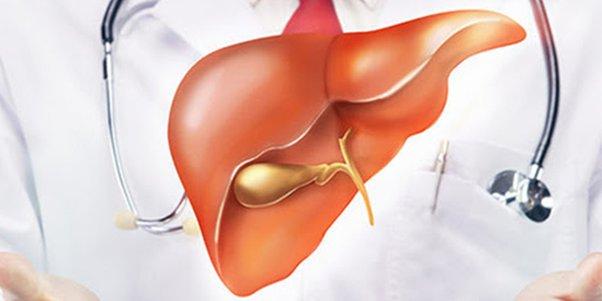Liver diseases are health issues that predominantly affect the liver and have the potential to cause long-term liver damage if left untreated. Infections, immune-mediated diseases, metabolic diseases, and hereditary ailments are examples of these. If you have been diagnosed with any type of chronic liver illness, you should consider being vaccinated against hepatitis A and B to eliminate the possibility of contracting either of these viruses.

Alcohol-related liver illness
Chronic alcohol consumption and abuse can lead to chronic liver damage. Ethanol, which is found in alcoholic beverages, is predominantly processed by the liver. Once ethanol is processed by the liver, the byproducts of metabolism have the potential to harm the liver. There are three forms of liver damage produced by alcohol.
Alcoholic hepatitis is typically an acute inflammation of the liver induced by excessive alcohol consumption. This can result in jaundice, fevers, and right upper abdomen pain, and if serious enough, may necessitate hospitalization
Alcoholic liver disease can be avoided and treated. Women are more susceptible to alcohol-induced liver impairment than men due to differences in how alcohol is processed. Abstinence from alcohol is the most common treatment for alcohol-induced liver damage. With the absence of alcohol, liver damage can sometimes be reversed, at least partially.
Hepatitis B
Hepatitis B is a viral infection transmitted through the blood that affects the liver. It affects around 200 million individuals worldwide. The body's immune system can completely fight off an acute viral infection in some people, but in others, the immune system is unable to destroy all of the viruses, and the acute infection progresses to a chronic infection. Depending on the age at when one becomes acutely infected, the illness has a varying risk of moving from an acute, self-resolving infection to a chronic infection that may require treatment. If the infection is acquired at birth, around 90% of people will develop a chronic infection, whereas less than 5% will develop a chronic infection if acquired as an adult.
Hepatitis B symptoms can vary greatly. People may be asymptomatic or have lethargy, nausea, vomiting, jaundice, rashes, joint problems, or even liver failure and death. Hepatitis B is a curable infection that is most usually treated with daily oral medicines. Most infants are now immunized against hepatitis B at birth to reduce the risk of infection throughout their lives. Vaccines were first made available in the late 1980s and early 1990s. Adults can readily receive the vaccine series if they have not yet been immunized. We are delighted to provide this immunization series in our offices.
Hepatitis C
Chronic hepatitis C symptoms are generic and can arise in a variety of medical illnesses and scenarios. Fatigue, nausea/vomiting, loss of appetite, jaundice, rash, and muscle/joint problems are some of the symptoms.
As previously stated, once a person gets a chronic hepatitis C infection, the viral infection will continue to harm the liver unless treated. There have been surprising and exciting developments in the treatment of hepatitis C during the last year. Current therapy regimens include far fewer adverse effects, shorter treatment courses, and cure rates for certain persons as high as 95-99 percent.
Fatty liver disease
There are two forms of fatty liver disease: alcoholic fatty liver disease and non-alcoholic fatty liver disease. As described in the section on alcoholic liver diseases, alcoholic fatty liver disease is caused by the accumulation of fat in the liver as a result of continuous alcohol consumption. Non-alcoholic fatty liver disease (NAFLD) is the second subtype, characterized by the buildup of fat in the liver in the absence of significant alcohol consumption (less than 2 drinks per day).
Patients with a history of metabolic syndrome including obesity, diabetes, high blood pressure, or high cholesterol are more likely to develop NAFL and NASH. Central obesity, high triglycerides, low high-density lipoprotein (HDL), high low-density lipoprotein (LDL), high blood pressure, or insulin resistance are all symptoms of metabolic syndrome. Furthermore, a small percentage of NAFLD patients are not obese and have a normal BMI.
Autoimmune liver disease
Autoimmune liver illnesses are chronic autoimmune medical problems in which the immune system mistakenly attacks the liver. Typically, our immune systems are geared to combat "external" things like bacteria, viruses, and parasites, rather than ourselves. The immune system targets our own bodies in autoimmune illnesses. There are two forms of autoimmune liver diseases: Autoimmune Hepatitis (AIH) and Primary Biliary Cirrhosis (PBC) (PBC). AIH occurs when the immune system attacks the liver cells, resulting in inflammation, scarring, and potentially cirrhosis if left untreated. In PBC, the immune system assaults the bile ducts within the liver, which, if left untreated, can develop into cirrhosis.
Inherited and metabolic liver disease
Hereditary Hemochromatosis and Wilson's Disease are the two most frequent metabolic and hereditary liver illnesses. Both of these disorders are linked to metal accumulation in the liver. The metal infiltrates the liver and causes damage to it over time.
Hereditary Hemochromatosis is a genetically inherited condition in which our bodies are unable to balance the quantity of iron in our bodies properly. Certain genes and proteins regulate iron transport throughout our bodies and are also in charge of excreting excess iron. These systems do not function properly in hemochromatosis,
